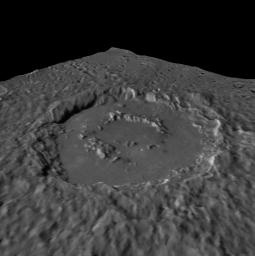
|
Starry Hour
- Click the image above for a larger view
- Full-Res JPEG (507 x 508) (26.8 kB)
- Full-Res TIFF (507 x 508) (258.0 kB)
Caption:
Today's image features a perspective view of the Alver crater, recently named for Estonian poet Betti Alver (1906-1989). Alver's husband was imprisoned and died in Siberia after World War II, leading Alver to stop writing poetry for many years in protest of Soviet rule. She resumed writing poetry in the 1960s, composing the notable 1966 collection Tähetund or "Starry Hour."
To create this image, a portion of the MDIS monochrome basemap was draped over a digital elevation model. The topography has been exaggerated by 5 times to accentuate the crater rim and central peak ring. The view is looking towards the southeast. Alver is a complex crater in the southern hemisphere of Mercury. This perspective view highlights the smooth nature of the basin floor relative to the ejecta blanket and surrounding terrain.
Instrument:
Mercury Dual Imaging System (MDIS)
Center Latitude:
-67.0°
Center Longitude:
77.9° E
Basemap Resolution:
approximately 250 meters/pixel
Digital Elevation Model:
Produced by
MESSENGER Participating Scientist Bob Gaskell
based on MDIS images
Vertical Exaggeration
: 5 times actual
Scale:
Alver crater is 151.5 km (94.1 miles) across
Background Info:
The MESSENGER spacecraft is the first ever to orbit the planet Mercury, and the spacecraft's seven scientific instruments and radio science investigation are unraveling the history and evolution of the Solar System's innermost planet. MESSENGER acquired over 150,000 images and extensive other data sets. MESSENGER is capable of continuing orbital operations until early 2015.
For information regarding the use of images, see the MESSENGER image use policy .
Cataloging Keywords:
| Name | Value | Additional Values |
|---|---|---|
| Target | Mercury | |
| System | ||
| Target Type | Planet | |
| Mission | MESSENGER | |
| Instrument Host | MESSENGER | |
| Host Type | Orbiter | |
| Instrument | Mercury Dual Imaging System (MDIS) | |
| Detector | ||
| Extra Keywords | Crater, Grayscale, Map, Radio | |
| Acquisition Date | ||
| Release Date | 2013-04-19 | |
| Date in Caption | ||
| Image Credit | NASA/Johns Hopkins University Applied Physics Laboratory/Carnegie Institution of Washington | |
| Source | photojournal.jpl.nasa.gov/catalog/PIA16992 | |
| Identifier | PIA16992 | |
